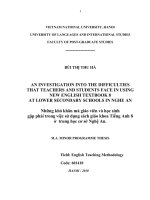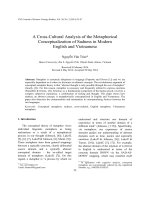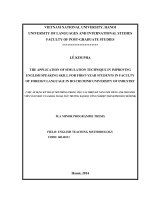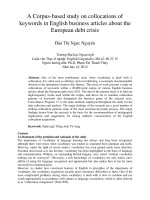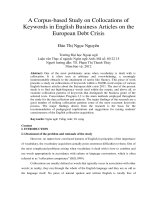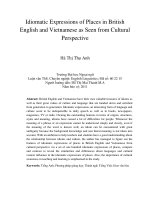Adaptation strategies on lessons of skills in pilot english textbook series for lower secondary schools under task based learning approach
Bạn đang xem bản rút gọn của tài liệu. Xem và tải ngay bản đầy đủ của tài liệu tại đây (3.03 MB, 166 trang )
VIETNAM NATIONAL UNIVERSITY, HANOI
UNIVERSITY OF LANGUAGES AND INTERNATIONAL STUDIES
FACULTY OF POSTGRADUATE STUDIES
DƯƠNG THỊ LOAN
ADAPTATION STRATEGIES ON LESSONS OF SKILLS IN PILOT
ENGLISH TEXTBOOK SERIES FOR LOWER SECONDARY
SCHOOLS UNDER TASK-BASED LEARNING APPROACH
CÁC CHIẾN LƯỢC ĐIỀU CHỈNH CÁC BÀI DẠY KĨ NĂNG TRONG
SÁCH GIÁO KHOA TIẾNG ANH THCS THÍ ĐIỂM DƯỚI CÁCH TIẾP
CẬN CỦA PHƯƠNG PHÁP DẠY HỌC NGÔN NGỮ
DỰA VÀO NHIỆM VỤ
M.A. MINOR PROGRAMME THESIS
Field: English Teaching Methodology
Code: 8220201.01
HA NOI, 2020
VIETNAM NATIONAL UNIVERSITY, HANOI
UNIVERSITY OF LANGUAGES AND INTERNATIONAL STUDIES
FACULTY OF POSTGRADUATE STUDIES
DƯƠNG THỊ LOAN
ADAPTATION STRATEGIES ON LESSONS OF SKILLS IN PILOT
ENGLISH TEXTBOOK SERIES FOR LOWER SECONDARY
SCHOOLS UNDER TASK-BASED LEARNING APPROACH
CÁC CHIẾN LƯỢC ĐIỀU CHỈNH CÁC BÀI DẠY KĨ NĂNG TRONG
SÁCH GIÁO KHOA TIẾNG ANH THCS THÍ ĐIỂM DƯỚI CÁCH TIẾP
CẬN CỦA PHƯƠNG PHÁP DẠY HỌC NGÔN NGỮ
DỰA VÀO NHIỆM VỤ
M.A MINOR THESIS
Field: English Teaching Methodology
Code: 8220201.01
Supervisor: Dr. Nguyen Viet Hung
HA NOI, 2020
DECLARATION
I certify that the thesis entitled “Adaptation Strategies On Lessons Of Skills In Pilot
English Textbook Series For Lower Secondary Schools Under Task-Based Learning
Approach” is my own research requirement for the Degree of Master of Arts in
English Teaching Methodology Program at the Faculty of Post-graduate Studies,
University of Languages and International Studies, Vietnam National University,
Hanoi.
Signature
Duong Thi Loan
i
ABSTRACT
This study sought to evaluate the appropriateness of skills lessons in Tieng Anh 6Thi Diem to weak students and techniques for adapting the skills lessons, using case
study methodology. The evaluation based on data collected from 2 teachers and 71
students from two weak classes at a lower secondary school in Hanoi in the form of
questionnaires, semi-structured interviews, and classroom observations. Preadaptation questionnaires and interviews were to collect students‟ and teachers'
evaluation of skills lessons in Tieng Anh 6- Thi Diem. The findings showed that in
order to fit weak student‟s needs at the lower secondary school in the research,
some skills lessons needed some improvements in input and output relevance, text
and illustration relevance, sequence of questions and activities, and scaffolding and
recycling activities. Therefore, Maley (1998) adaptation techniques were used under
Nunan (1991 & 2004) Task-Based Language Approach principles to improve the
skills lessons. These adapted skills lessons were then delivered and then assessed by
teacher and student participants. All data from the findings indicated that adapted
skills lessons satisfied teachers‟ and students‟ needs in the research. Briefly, the
study proposed some adaptation strategies on skills lessons under TBLA which
teachers could utilize to increase the effectiveness of skills lessons when teaching
Tieng Anh 6- Thi Diem in a particular teaching and learning context.
ii
ACKNOWLEDGEMENTS
My research project has been completed with the support of a great number of
people. First, I am greatly indebted to my supervisor, Dr. Nguyen Viet Hung for his
support, encouragement, and valuable advice throughout this research. With his
excellent insights and patient guidance, this thesis has been made possible. I also
would like to especially thank anonymous participants who contributed data to this
study. Finally, I would like to express my special thanks to my family for their
support and encouragement throughout my study.
iii
TABLE OF CONTENT
DECLARATION ....................................................................................................... i
ABSTRACT .............................................................................................................. ii
ACKNOWLEDGEMENTS .................................................................................... iii
TABLE OF CONTENT .......................................................................................... iv
LIST OF ABBREVIATIONS................................................................................ vii
LIST OF TABLES ................................................................................................ viii
LIST OF FIGURES ................................................................................................ ix
CHAPTER 1: INTRODUCTION ............................................................................1
1.1. Rationale ..............................................................................................................1
1.2. Aims of the study and research questions ............................................................2
1.3. Significance of the study ......................................................................................2
1.4. Scope of the study ................................................................................................2
1.5. Organization of the thesis.....................................................................................3
CHAPTER 2: LITERATURE REVIEW ................................................................4
2.1. Task-Based Learning Approach ...........................................................................4
2.1.1. Definitions of “task” .........................................................................................4
2.1.2. Frameworks for TBLA ......................................................................................5
2.1.3. Principles for TBLA ..........................................................................................8
2.2. Textbook, textbook evaluation, and textbook adaptation ..................................12
2.2.1. Roles of textbooks in ELT ..............................................................................12
2.2.2. Textbook evaluation ........................................................................................13
2.2.3. Textbook adaptation ........................................................................................15
2.3. Textbook Adaptation under TBLA ....................................................................20
CHAPTER 3: RESEARCH METHODOLOGY .................................................23
3.1. Research approach .............................................................................................23
3.2. Restatement of research questions .....................................................................23
3.3. The setting of the study ......................................................................................23
3.3.1. The setting of the study ...................................................................................23
iv
3.3.2. Participants ......................................................................................................24
3.4. Data collection instruments ................................................................................25
3.4.1. Questionnaire ..................................................................................................25
3.4.2. Interview .........................................................................................................27
3.4.3. Classroom observation ....................................................................................28
3.5. Data collection procedures .................................................................................28
3.6. Data analysis procedures ....................................................................................29
CHAPTER 4: THE FINDINGS AND DISCUSSION OF THE FINDINGS .....31
4.1. Evaluation of skills lessons in Tieng Anh 6- Thi Diem before the adaptation ...31
4.1.1. Teachers‟ opinions of the skills lessons before the adaptation .......................31
4.1.2. Students‟ opinions of the skills lessons before the adaptation ........................37
4.1.3. Summary of teachers‟ and students‟ opinions before the adaptation .............44
4.2. Description of adapted skills lessons in Tieng Anh 6-Thi Diem under TBLA...44
4.2.1. Omission .........................................................................................................45
4.2.2. Addition...........................................................................................................45
4.2.3. Rewriting/Modification ...................................................................................46
4.2.4. Replacement ....................................................................................................49
4.2.5. Re-ordering .....................................................................................................49
4.3. Evaluation of skills lessons in Tieng Anh 6- Thi Diem after the adaptation ......51
4.3.1. Overall opinion................................................................................................51
4.3.2. Scaffolding ......................................................................................................54
4.3.3. Task dependency .............................................................................................56
4.3.4. Recycling.........................................................................................................59
4.3.5. Authentic materials .........................................................................................60
4.3.6. Summary of teachers‟ and students‟ opinions after the adaptation ................61
4.4. Summary of the findings ....................................................................................61
CHAPTER 5: CONCLUSION ...............................................................................65
5.1. Summary of the research ....................................................................................65
5.2. Conclusion..........................................................................................................65
v
5.3. Implications ........................................................................................................66
5.4. Limitations of the study .....................................................................................67
5.5. Suggestions for further studies ...........................................................................67
REFERENCES ........................................................................................................68
APPENDICES ........................................................................................................... I
Appendix 1: Nunan (2004) checklist for task evaluation ........................................... I
Appendix 2: McGrath (2002) checklist for textbook evaluation ............................. IV
Appendix 3: Cunningsworth (1995) checklist for textbook evaluation .................. VII
Appendix 4: Questionnaire for Students before the Adaptation ................................ X
Appendix 5: Questionnaire for Students after the Adaptation .............................. XVI
Appendix 6: Semi-structured Interview Checklist Before the Adaptation (English
and Vietnamese versions) ..................................................................................... XXI
Appendix 7: Semi-structured Interview Checklist After the Adaptation (English and
Vietnamese versions) ..........................................................................................XXIV
Appendix 8: Written transcript of taped interviews (English Translation)....... XXVII
Appendix 9: Classroom Observation Form ........................................................ XXIII
Appendix 10: Guidelines for Classroom Observation ........................................XXIV
Appendix 11: Lesson Observation Sheets ........................................................... XXV
Appendix 12: Samples of students‟ writing ..................................................... XXXIV
Appendix 13: Adapted skills lessons in Tieng Anh 6- Thi Diem ..................... XXXVI
vi
LIST OF ABBREVIATIONS
ELT: English Language Teaching
MOET: Ministry of Education and Training
N: Number of participants
TBLA: Task-Based Learning Approach
vii
LIST OF TABLES
Table 1: Salaberry‟s framework for TBLA (Salaberry, 2001) ...................................7
Table 2: Teacher participants‟ profile .......................................................................25
Table 3: Summary of students‟ evaluation on activities‟ instructions ......................38
Table 4: Summary of students‟ evaluation on illustrations.......................................38
Table 5: Summary of students‟ evaluation on pre-speaking and pre-writing activities
...................................................................................................................................39
Table 6: Summary of students‟ evaluation on activities‟ sequence ..........................39
Table 7: Summary of students‟ evaluation on questions‟ sequence in one activity .40
Table 8: Summary of students‟ evaluation on skills lessons ....................................41
Table 9: Summary of students‟ evaluation on the familiarity of lessons‟ topic .......42
Table 10: Summary of students‟ evaluation on the naturalness of language ............42
Table 11: Summary of students‟ evaluation on adapted Skills 1-Unit 9 ..................52
Table 12: Summary of students‟ evaluation on adapted Skills 2-Unit 8 ..................52
Table 13: Summary of students‟ evaluation on scaffolding in adapted Skills 1-Unit
9 .................................................................................................................................55
Table 14: Summary of students‟ evaluation on scaffolding adapted Skills 2-Unit 855
Table 15: Summary of students‟ evaluation on sequence in adapted Skills 1-Unit 9
...................................................................................................................................57
Table 16: Summary of students‟ evaluation on sequence in adapted Skills 2-Unit 8
...................................................................................................................................58
viii
LIST OF FIGURES
Figure 1: Willis‟ framework for TBLA (adapted from Willis, 1996, 2012)...............6
Figure 2: The cycle of textbook adaptation (Grave, 2000, p205) .............................17
Figure 3: A framework for textbook adaptation (McDonough, Shaw, & Masuhara,
2013)..........................................................................................................................18
Figure 4: Framework for Textbook adaptation under TBLA ...................................22
ix
CHAPTER 1: INTRODUCTION
1.1. Rationale
With the aim of promoting English language teaching and learning throughout
Vietnam in all school level, on 30th September 2008, Ministry of Education and
Training (MOET) announced Decision No. 1400/QĐ-TTg “Teaching and Learning
Foreign Languages in the National Education System, Period 2008 to 2020”.
In order to attain the goal of National Foreign Language 2020 Project, in 2010
Vietnam Educational Publishing House, in collaboration with MacMillan Education
and Pearson Education, published a new series of English textbooks for Vietnamese
schools from grade 3 to grade 12 under MOET decision. This English textbook
series has been piloted in selected schools all over Vietnam since 2011.
The lower secondary school where the study was carried out is implementing this
textbook series. Students in this school are placed into classes at appropriate
academic level basing on their placement test scores. Therefore, there are classes at
different levels of competence in English, from strong to weak ones. It is reported
that many students in weak classes had difficulties in dealing with activities,
especially in skills lessons. The difficulties arose not only due to student‟s
incompetence but also because Tieng Anh 6- Thi Diem is designed for public use,
not for any particular learning environment. Therefore, some skills lessons are too
difficult for weak classes in the author‟s school. This makes teachers spend more
time on planning the lesson as well as explaining the tasks for students. It is
assumed that if TBLA and its philosophy had been adopted in adapting Tieng Anh
6- Thi Diem, such raising matters could have been solved. This reality motivated me
to conduct this study to contribute my modest understanding of TBLA in adapting
skills lessons in Tieng Anh 6- Thi Diem.
1
1.2. Aims of the study and research questions
The study is an attempt to evaluate activities and tasks of skills lessons in Tieng Anh
6- Thi Diem to grade 6 classes at a lower secondary school in Hanoi, and assess the
effectiveness of adaptation techniques on the lessons skills under TBLA. In brief,
the study seeks to address the following questions:
1. What are teachers‟ opinions about the activities in original skills lessons in
Tieng Anh 6- Thi Diem?
2. What are students‟ opinions about the activities in original skills lessons in
Tieng Anh 6- Thi Diem?
3. What are teachers‟ and students‟ opinions about activities in Tieng Anh 6Thi Diem adapted under TBLA?
1.3. Significance of the study
This study has been carried out to search for useful techniques to adapt skills
lessons in Tieng Anh 6- Thi Diem under TBLA. This research utilizes the principles
of TBLA to adapt skills lessons in Tieng Anh 6- Thi Diem in order to make the
lessons more suitable to the level of weak students. Its findings hopefully would
help teaching and learning Tieng Anh 6- Thi Diem skills lessons in weak classes
within the author‟s context become more effective.
1.4. Scope of the study
The thesis does not cover skills lessons in pilot English textbooks of all levels, but
focuses on skills lessons in Tieng Anh 6-Thi Diem due to the author‟s limited
ability, time constraints and narrow-scaled study. The strategies mentioned in this
study are techniques to adapt activities and tasks in skills lessons in Tieng Anh 6-Thi
Diem. Additionally, this study was conducted in a lower secondary school in Hanoi.
Only a small number of grade 6 teachers and weak students participated in the
study.
2
1.5. Organization of the thesis
Chapter 1 presents the basic information of the study, namely rationale, research
questions, significance, scope and organization. Chapter 2 is the literature review of
various concepts of Task-Based Learning Approach (TBLA), material evaluation,
material development, and material adaptation. Chapter 3 covers the method of
investigation which includes participants, instruments, methods of data collection
and data analysis. In Chapter 4, the author gives a detailed presentation of data,
description of data analysis, and explanations and interpretations of the findings of
the study. This chapter also presents description of adapted skills lessons in Tieng
Anh 6- Thi Diem under TBLA. Chapter 5 will deal with a review of the study,
consider some limitations and give some suggestions for further study. In the last
part of the study, to assure that the thesis is really valid, the researcher gives
references and appendices.
3
CHAPTER 2: LITERATURE REVIEW
2.1. Task-Based Learning Approach
2.1.1. Definitions of “task”
The concept of “task” has become an important element in syllabus design,
classroom teaching and learner assessment. There have been numerous variations of
“task” definitions. A pioneering study on language tasks is from Prabhu (1987, p.
24) who sees a task as "an activity which required learners to arrive at an outcome
from given information through some process of thought, and which allowed
teachers to control and regulate that process".
Another definition of “task” was provided by Richards, Platt and Weber in 1986:
“…an activity or action which is carried out as the result of processing or
understanding language (i.e. as a response). For example, drawing a map while
listening to a tape, listening to an instruction and performing a command may be
referred to as tasks. Tasks may or may not involve the production of language. A
task usually requires the teacher to specify what will be regarded as successful
completion of the task. The use of a variety of different kinds of tasks in language
teaching is said to make language teaching more communicative … since it
provides a purpose for a classroom activity which goes beyond the practice of
language for its own sake.” (as cited in Nunan, 2006).
Nunan (2006) in an article about TBLA defined “tasks” in the following way: “a
task is a piece of classroom work that involves learners in comprehending,
manipulating, producing or interacting in the target language while their attention is
focused on mobilizing their grammatical knowledge in order to express meaning,
and in which the intention is to convey meaning rather than to manipulate form. The
task should also have a sense of completeness, being able to stand alone as a
communicative act in its own right with a beginning, a middle and an end.”
Branden (2006); Ellis (2009); & Skehan (1998) define a task as an activity or a
series of activities which have a primary focus on meaning (i.e. learners are engaged
4
in understanding and producing messages designed to communicate information
and opinions); contain a gap of some kind (information, opinion, reasoning); allow
the learners to use their own linguistic resources (i.e. they do not simply reproduce
language given to them); and have an outcome other than the display of correct
language.
Although these definitions are different in some ways, they share the same
underlying assumption that tasks “involve communicative language use in which
the user‟s attention is focused on meaning rather than grammatical form” (Nunan,
2006). Nevertheless, this does not mean that TBLA neglects grammatical form.
2.1.2. Frameworks for TBLA
Various frameworks of a task-based lesson have been proposed. In general, TBLA
framework is generally used to refer to the sequence of subtasks within tasks to
form the stages. The stages in one TBLA framework are different from one another
since each researcher has their own ways of perceiving TBLA framework.
Firstly, the three-phase TBLA framework is approved by Prabu (1987), Estaire and
Zanon (1994), Skehan (1996), Willis (1996), Ellis (2006) and Willis (2009). Three
stages in this framework are pre-task, task cycle, and language focus. As can be
seen in Figure 1, a framework for TBLA proposed by Willis (1996), pre-task
includes different preparing activities by introducing vocabulary items, promoting
initial ideas of the topic of the main task, and other language features. These
activities help students to perform the task confidently and effectively. Ellis (2006)
states that pre-task activities can be used to “scaffold learners‟ performance of the
task with the expectancy that this „other-regulation‟ facilitates the „self-regulation‟
learners will need to perform the main task on their own.” In the second phase,
students are required to undertake a task where students have opportunities to
experience using the language. By discussing with their partner or in groups, and
reporting to the class, students develop their language fluency. Finally, there are
following-up activities in the final phase of language focus which helps improve
5
learners‟ accuracy. This means that in this phase, students have a chance to focus on
specific language forms which students already encounter in the previous stages. In
this model, the teacher is expected to lead the class step-by-step to the expected
outcome, to break down a step into smaller steps if the learners encounter
difficulties and to offer one of more parallels to a step in the reasoning process to
ensure that mixed ability learners could understand what is required (Ellis, 2006).
Figure 1: Willis‟ framework for TBLA (adapted from Willis, 1996, 2012)
Another model of TBLA is built by Salaberry (2001) using the concept of the three
Is (Illustration, Interaction, and Induction) proposed by McCarthy (1998). Students‟
and teachers‟ stages are shown in Table 1. As described by the author, students are
introduced to the topic and motivated to participate in a task in the first step. Then,
6
communicative analysis of language in communicative context is carried out. This
is mostly initiated by learners, not the teacher. During the third stage, students have
chances to practice and develop hypotheses about structure and functions of the
language. Finally, students are required to produce a piece of work using the newly
acquired features of the language.
Teacher
Learner
1. Introduction of topic
1. Involvement
2. Illustration
2. Inquiry
3. Implementation
3. Induction
4. Integration
4. Incorporation
Table 1: Salaberry‟s framework for TBLA (Salaberry, 2001)
Nunan (2006) introduces a procedure of six steps in his book on TBLA. The first
step, schema building, is similar to Willis‟ pre-task phase whose purpose is to
“introduce the topic, set the context for the task, and introduce some of the key
vocabulary and expressions that the students will need in order to complete the
task.” (Nunan, 2006). This is followed by controlled practice that extends the
scaffolded learning that is initiated in step one by having students take part in using
the target language vocabulary, structures and functions. Next, students are exposed
to authentic listening practice, which extends the language from the model
conversation in step two. After that, students have a chance to focus on linguistic
elements by completing a sequence of exercises in which the focus is on one or
more linguistic elements. In step five, provide freer practice, students are
encouraged to express ideas using their own words. Finally, teacher introduces the
pedagogical task to students who are asked to take part in a group work discussion
and decision-making task. In Nunan‟s framework, the form-focused activity occurs
before the task while Willis suggests putting a focus on form after the task.
7
In summary, although many frameworks for TBLA are proposed from different
perspectives, they all bear the fundamental similarity that sequencing is a major
characteristic of TBLA. As can be seen in the aforementioned models, scaffolding
is implicitly and explicitly regarded as an indispensable part of TBLA. It is also
important to note that, in addition to focusing on meaning, focusing on form also
plays a crucial role in a TBLA framework.
2.1.3. Principles for TBLA
Nunan (1991: 279) mentions five characteristics of a TBLA framework. In his later
research, Nunan (2004) proposed seven principles for TBLA which are: scaffolding,
task dependency, recycling, active learning, integration, reproduction to creation,
and reflection. He suggested that these principles could be used to evaluate the
materials or textbooks.
2.1.3.1. Scaffolding
The first principle, scaffolding, refers to a supporting framework that lessons and
materials provide to facilitate learning. Scaffolding appears through the use of
“simplified language, teacher modeling, visuals and graphics, cooperative learning
and hands-on learning” (Ovando, Collier, & Combs, 2003, p. 345). The reason for
scaffolding is that “At the beginning of the learning process, learners should not be
expected to produce language that has not been introduced either explicitly or
implicitly” (Nunan, 2004). Nunan also suggests that timing is crucial when deciding
to remove the supporting framework. This means that scaffolding should be
removed when the students are more confident and proficient.
2.1.3.2. Task dependency
The next principle, task dependency, means “within a lesson, one task should grow
out of, and build upon, the ones that have gone before” (Nunan, 2004, p.35-36).
This principle suggests that each task should take advantage of and be designed
basing on the one before. This is aimed to lead learners step by step to the point
final pedagogical task in the sequence.
8
This principle includes the receptive-to-productive principle and reproductive-tocreative-language principle. The receptive-to-productive principle refers to the
proportion of time engaged in receptive (listening and reading) tasks and in
productive ones: first, students spend more time in receptive tasks than in
productive ones; later, they spend more time in productive work. The reproductiveto-creative-language principle, which is also about the sequencing of tasks, is
introduced sepeartely below.
2.1.3.3. Recycling
Another important rule for task is recycling where opportunities are created for
students to come into with target language in different types of activities. Nunan
stated that, in a task-based syllabus, grammatical and functional items will reappear
numerous times in a diverse range of contexts. This would appear to be healthy for
second language acquisition because it allows learners to „restructure‟ and develop
an elaborated understanding of the item in question.
2.1.3.4. Active learning
The fourth fundamental is active learning where students actively use the language
they are learning to express themselves. “A key principle behind this concept is that
learners learn best through doing – through actively constructing their own
knowledge rather than having it transmitted to them by the teacher” (Nunan, 2004).
This suggests that controlled practice should be limited; dependence on the teacher
should be reduced.
2.1.3.5. Integration
Regarding principle integration, it is advised to teach lessons where “linguistic
elements – the grammatical, lexical and phonological components” – are integrated.
This means that the teachers as well as textbooks should demonstrate the
relationships between form, function and meaning to learners of English.
9
2.1.3.6. Reproduction to creation
After finishing reproductive tasks, students should be encouraged to fulfill creative
ones. Reproductive tasks are the ones requring students reproduce language basing
on examples supplied by their teachers. The aim of these tasks is to prepare students
for creative tasks through knowledge about or understanding of form, meaning and
function. After that, students move to the tasks in which they can reuse introduced
language elements creatively. Nunan (2004) recommends that this principle can be
appropriate to students at both elementary and intermediate levels.
2.1.3.7. Reflection
This principle emphasizes the significance of the opportunities that students have to
“reflect on what they have learned and how well they are doing” (Nunan, 2004).
This helps students to be conscious of the strategies driving their learning and the
reasons for their learning, which makes them become better learners according to
Nunan (2004).
2.1.3.8. Authentic materials
Nunan (1991: 279) mentions five characteristics of a TBLA framework:
An emphasis on learning to communicate through interaction in the target
language.
The introduction of authentic texts (teaching materials) into the learning
situation.
The provision of opportunities for learners to focus not only on language, but
also on the learning process itself.
An enhancement of the learner‟s own personal experiences as important
contributing elements to classroom learning.
An attempt to link classroom language learning with language activation
outside the classroom.
10
In 2004, Nunan proposed a six-step procedure of a task-based lesson. This step
would expose them to authentic or simulated conversation through the listening
texts that involve a number of native speakers talking to each other about certain
topics. In this step, authentic materials play a vital role in incorporating and
extending the language from the model conversation for the learners.
Through above-mentioned features, it can be noted that authentic materials play an
important part in a TBLA framework because real-life conversations and situations
have several advantages to the process of language learning. Authentic materials
can help students connect the language classroom with the outside world (Brinton,
1991). Gebhard (1996) sees authentic materials as a way to give students a valuable
source of language input from the real world context, so that they are not being
exposed only to the language presented by the text and the teacher.
2.1.3.9. Summary
Basing on the aforementioned TBLA principles, four criteria for evaluating skills
lessons in Tieng Anh 6-Thi Diem were developed, which are (1) scaffolding, (2) task
dependency, (3) recycling, and (4) authentic materials. These principles were
chosen because of their compatibility with this thesis‟ purpose of evaluating and
adapting skills lessons under TBLA to suit the levels of grade 6 weak students in
this research.
Some princiles are not chosen to evaluate skills lessons in this research. First, active
learning is not used due to the author‟s limited ability, time constraints and narrowscaled study. In order to evaluate skills lessons basing on this principle the
researcher needs to observe every original skills lesson to see whether teacherfocused work dominate class time or not. Second, integration is not used to evaluate
skills lessons because this criterion is more suitable to evaluate grammar and
vocabulary lessons. Finally, reproduction to creation is already included in task
dependency as stated by Nunan (2004). Finally, the book gives students chances to
reflect their learning in Looking back lessons which are the last lessons of every
11
unit, not in skills lessons. Therefore, this principle is not applicable to this thesis‟
purpose.
2.2. Textbook, textbook evaluation, and textbook adaptation
2.2.1. Roles of textbooks in ELT
Sheldon (1988, p. 237) suggests that textbooks not only "represent the visible heart
of any ELT program" but also offer considerable advantages - for both teachers and
learners - when they are being used in the English as a Second Language and
English as a Foreign Language classroom as cited in Nguyen (2007).
Teachers can benefit from textbooks in a variety of ways. The first advantage of
textbooks is that they provide teachers of English with a source of teaching
materials. Thus, teachers do not have to spare time preparing teaching materials
themselves. Therefore it “saves time, gives direction to lessons, guides discussion,
facilitates giving of homework, making teaching „easier, better organized, more
convenient‟ and learning „easier, faster, better‟. This view is advocated by
Hutchinson and Torres (1994) who state that “Almost all of textbooks provide
confidence and security” (p.315). Secondly, textbooks can fulfill the need of a map
or a plan for sequences of lessons. A lesson is one of “an incremental sequence of
teaching units, the sequence as a whole meant to achieve a larger objective” as
characterized by Prabhu in 1992 (as cited in Hutchinson and Torres, 1994).
Therefore, lessons should not be taught separately, but in relation to each other. The
previous lessons act as a scaffolding element for coming-up lessons. A textbook, as
stated by Hutchinson and Torres (1994), is capable of satisfying this demand.
Students consider textbooks as a guideline for their learning in class like
discussions, doing activities and exercises; and outside the classroom such as doing
homework, or preparing for tests. Textbooks facilitate students‟ learning and make
students learn “better, faster, clearer, easier, more” (Hutchinson and Torres, 1994).
12
Since textbooks are vital in ELT, the process of selecting, evaluating and adapting
course books to suit each learning context has significant impacts on the
effectiveness of English language teaching and learning process.
2.2.2. Textbook evaluation
Textbook evaluation is an important process in language teaching and learning. By
evaluating the textbook, teachers can “acquire useful, accurate, systematic, and
contextual insights into the overall nature of the textbook” (p.7) as described by
Cunningsworth (1995) and Ellis (1997). Consequently, it helps teachers understand
the textbook so that they can change their teaching to suit the course aims, and
learners‟ needs.
Depending on the teaching and learning context, teachers and educators select the
most suitable framework to follow. Therefore, a number of different criteria for
material evaluation have been introduced by Ellis (1997), McDonough and Shaw
(1998) McGrath (2002), Tomlinson (2003).
A two-stage textbook evaluation approach is suggested by Ellis‟s (1997). This
includes predictive evaluation and retrospective evaluation. Predictive evaluation
decides which textbook will be used for the course. Once they have been used,
retrospective evaluation may be conducted to find out what impact they have had on
instructors and learners. The first stage, predictive evaluation, as its name suggests,
is based on the first impression of evaluators about a textbook so it is somehow
subjective. Hence, teachers need to take a further evaluation by retrospective
evaluation which takes place in and after the process of teaching and learning.
Basing on the feedback from textbook users, educators make decisions if the
textbook should or should not be used in the next course.
Tomlinson (2003) suggests a three-stage process of evaluation: pre-use evaluation,
whilst-use evaluation and post-use evaluation. The first stage, pre-use evaluation,
has some similarities to predictive evaluation by Ellis (1197) where the evaluators
take a quick look through a textbook (artwork, illustrations, appearance, content
13
pages, etc.) to gain an impression of its potential value. While teaching, teachers
evaluate the following criteria of the textbook: clarity of instructions, clarity of
layout, comprehensible of texts, credibility of tasks, achievement of performance
objectives, potential for localization, practicality of the materials, teachability of the
materials, flexibility of the materials, appeal of the materials, motivating power of
the materials, impact of the material, effectiveness in facilitating short-term. Finally,
at the stage of post-use evaluation, evaluators find out the impact of the textbook on
learners, teachers and administrators. The criteria in Tomlison (2003) are general
because of not clarifying what to look for in a textbook to measure the criteria.
Inexperience evaluators may encounter difficulties when adapting his criteria.
Cunningsworth (1995), at the very first pages of his book, introduces a “quickreference checklist” for textbook evaluation and selection with more specific
criteria and elements. In his checklist, there are eight main criteria (Aims and
approaches,
Design
and
organization,
Language
content,
Skills,
Topic,
Methodology, Teacher‟s guide, Practical considerations) which are followed by a
series of questions (see Appendix 2 for more details). Novice evaluators can easily
make objective judgments of their course book by answering those questions.
McGrath (2002) indicates textbook features that need evaluation in a two-step
procedure which consists of „first-glance‟ evaluation and „in-depth‟ evaluation. In
first-glance‟
step,
four
criteria
for
evaluators
are
mentioned:
practical
considerations; support for teaching and learning; context relevance; and learner
appeal. The second step, in-depth evaluation, involves following 7 key criteria each
of which contains specific evaluation questions which are (1) the aims and content
of the book, (2) what they require learners to do, (3) what they require the teacher to
do, (4) their function as a classroom resource, (5) learner needs and interests, (6)
learner approaches to language learning, and (7) the teaching – learning approach in
the teacher‟s own classroom (see Appendix 1 for more details).
14


